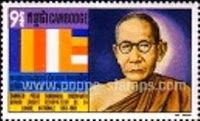The National Anthem of Cambodia (Nokoreach)

In the 1960s, Cambodia became more and more involved into the Vietnam war; to avoid conflicts with the USA and with communist North Vietnam, Prince Sihanouk declared Cambodia a neutral state, but he allowed North Vietnam to transport military goods through Cambodian territory to supply the communist Vietcong guerilla in South Vietnam with weapons and equipment. On 18th March 1970, General Lon Nol lead a military coup against Sihanouk and formed a pro-American government, which gave the US Army permission to fight against the Vietnamese communists on Cambodian territory. General Lon Nol proclaimed Cambodia the "Khmer Republic", and the country got a new flag and national anthem, which remained in use until the communist Khmer Rouge seized power in 1975.
It is unclear whether this anthem had words or not. A portion of what could be the anthems lyrics appears, translated into English, in Chanrithy Him's book "When Broken Glass Floats", yet information from the Khmer Embassy to Germany for the 1972 Olympic Games do not indicate any official lyrics.
When the radical communist Khmer Rouge guerilla conquered Phnom Penh on 17 April 1975, they first restored the old royalist symbols of state and made Prince Sihanouk again head of state. But in 1976, they declared Cambodia the "Democratic Kampuchea", and adopted its own anthem "Dap Prampi Mesa Chokchey" (Glorious Seventeenth of April) , in a typical communist style of anthem, commemorating the communist takeover of the capital. Although the text seems to predict the massacres caused by the Khmer Rouge by mentioning "blood" several times in the lyrics, it might also be the case that the lyrics rather took pattern from revolutionary songs in classical Marseillaise style. It has also been suggested that the leader of the Khmer Rouge (and president of the country during this time) Pol Pot may have written this anthem himself.
After Vietnamese forces and exile Cambodians invaded Cambodia in January 1979, Cambodia got a pro-Vietnamese, moderate communist government and was declared the People's Republic of Kampuchea. Again, a new flag and national anthem was adopted.
It is not totally certain how long this national anthem was in use; due to the continued pressure by the Khmer Rouge and royalist guerillas, Vietnam withdrew almost all its troops from Cambodia in 1989, and the Cambodian national assembly renamed the country into "State of Cambodia". At that occasion, a new flag and perhaps also a new national anthem were adopted. In 1991, a UN peace plan was signed, and the United Nations Transitional Authority in Cambodia (UNTAC) assumed administrative responsibility for Cambodia in March 1992, and adopted a new flag, which was in use until Cambodia became a Kingdom again in September 1993 and re-adopted its old symbols of state. Some sources mention that a textless tune, composed by Prince Ranariddh, was used as the national anthem during the time of the UNTAC administration.
The current national anthem "Nokoreach" (Royal Kingdom), was originally adopted in 1941 and reconfirmed in 1947, around the time of independence from France. In 1970, the monarchy was abolished, thereby replacing the anthem as well. After the communist victory in 1975, former royalist symbols, including "Nokoreach", were reinstated for a short while until replaced with their own national symbols. After the royalist forces defeated the communists in 1993, putting an end to their long civil war, the royalist anthem was also restored to Cambodia once more. The title of the anthem is derived from the name of an ancient Khmer kingdom. The music was composed by F. Perruchot and J. Jekyll, based on a Cambodian folk tune and the lyrics written by Chuon Nat.
(nationalanthems.info)
Samdech Sangha Raja Jhotañano Chuon Nath (March 11, 1883 – September 25, 1969) is the late Supreme Patriarch Kana Mahanikaya of Cambodia. Amongst his achievements is his effort in conservation of the Khmer language in the form of the Khmer dictionary. His protection of Khmer identity and history in the form of the national anthem, Nokor Reach and Savada Khmer are also amongst his contribution to the country.
The stamp above features Chuon Nat, the anthem lyricist.






